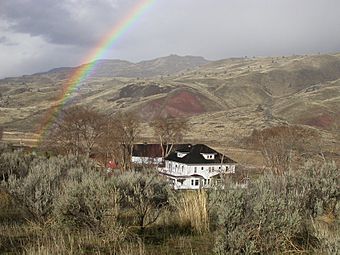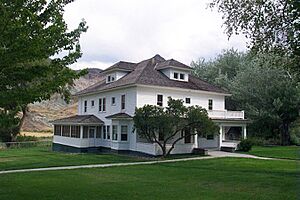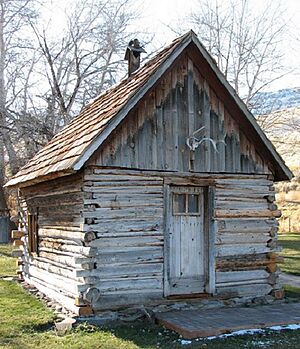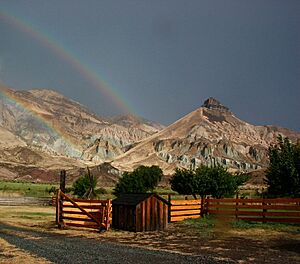James Cant Ranch Historic District facts for kids
Quick facts for kids |
|
|
James Cant Ranch Historic District
|
|

James Cant Ranch complex
|
|
| Location | John Day Fossil Beds National Monument |
|---|---|
| Nearest city | Dayville, Oregon |
| Area | Approx. 200 acres (81 ha) |
| Built | 1915–1918 |
| Architect | Radford Architectural Company |
| Architectural style | Common wood frame |
| NRHP reference No. | 84003000 |
| Added to NRHP | June 21, 1984 |
The James Cant Ranch is a historic ranch in eastern Oregon, United States. It's located in Grant County, right inside the John Day Fossil Beds National Monument. The ranch sits on both sides of the John Day River. A man named Floyd Officer first settled here in 1890. Later, James Cant bought the property in 1910. He made the ranch much bigger and built many new buildings on the west side of the river.
In 1975, the National Park Service bought the ranch from the Cant family. They made it part of the John Day Fossil Beds National Monument. The main house was used as a visitor center until 2003. Today, the Cant Ranch shows visitors what a livestock ranch was like in the early 1900s. The James Cant Ranch is an important historical site. It is listed on the National Register of Historic Places.
Contents
A Look at Early History
Native American Life
Long before European settlers arrived, Native American tribes lived around the John Day River. They used this area for thousands of years. The land where the Cant Ranch now stands was a place for seasonal hunting and fishing. The Warm Springs and Umatilla tribes, who spoke the Sahaptin language, used these lands. By the 1800s, Northern Paiute people also moved north from the Great Basin and used parts of the John Day River area.
Gold Rush and New Settlers
The weather in this area was very dry. Because of this, only a few trappers and prospectors came through before 1862. That year, gold was found in Canyon Creek, a stream that flows into the John Day River. This discovery brought many miners to the area. Mining towns quickly grew in northeastern Oregon. The biggest town was Canyon City. A wagon road was built in 1869. It connected Fort Dalles on the Columbia River to Canyon City. This road helped the area grow even more.
Ranching Begins
Soon after the miners, permanent settlers started arriving in the John Day Valley. The Homestead Act of 1862 helped people settle here. It offered 160 acres (0.65 km2) of land to American pioneers. Ranchers in the John Day area provided fresh meat to the mining towns. At first, most ranches raised beef cattle. But by the 1890s, sheep became the main animal raised on ranches. Many Scottish, Irish, and Basque immigrants, who were skilled sheep herders, moved to the area around this time.
In 1890, Floyd Officer claimed land in the Butler Basin along the John Day River. He worked on his 160-acre (0.65 km2) property for seven years. He officially owned the land in 1898. That same year, he married Sylvia Fitzgerald. They started a tough pioneer life on their remote farm. Floyd Officer knew the Butler Basin and Sheep Rock areas very well. He even guided pioneer paleontologist Thomas Condon on some of his fossil hunting trips.
The Officers sold their ranch in 1910. They moved to Dayville so their children could go to school. James Cant and his partner John Mason bought the property for $4,000. It included 357 acres (1.44 km2) in Grant County and another 320 adjoining acres (1.3 km2) acres in Wheeler County. James Cant bought out Mason's share of the ranch in 1915.
The Story of James Cant
James Cant was born in Scotland in 1879. When he was 20, he left Scotland for South America. He spent five years there raising horses and mules. In 1905, he moved to the United States. After arriving in New York City, Cant traveled to the John Day country in Oregon. Many Scottish immigrants already lived there. Alexander Murray, who owned a large ranch near Dayville, hired Cant as a sheep herder.
By 1908, Cant had saved enough money to bring his childhood sweetheart, Elizabeth Grant, from Scotland. They were married in Canyon City on October 10, 1908. Cant kept working on the Murray ranch for two more years. He saved enough money to buy the Officer ranch with John Mason.
After the Cants moved to the ranch, it became a popular stop for travelers. People often traveled between Dayville and the Columbia River. The Cants were known for their kindness. It was common for them to serve dinner to twenty or more people. This included family, ranch workers, and guests.
To make room for their growing family, more livestock, and many guests, the Cants greatly expanded the ranch between 1915 and 1918. They replaced most of the old buildings that the Officer family had built. As part of this expansion, Cant built a large main house. This house became the most important building on the ranch.
In the 1920s, Cant bought more land to grow his successful sheep business. He also made the area around the main house look nicer. He added a large lawn, fenced the yard, and planted many shrubs and trees. A big change happened when the State of Oregon started building Highway 19. This highway went from Arlington on the Columbia River to Dayville. The highway follows the John Day River and passes right by the Cant Ranch. It was finished in the mid-1920s, which meant the Cants were no longer so isolated. However, the highway was not paved until the mid-1930s.
The Cant family kept their sheep ranch going through the Great Depression. The ranch recovered some during World War II. But it became harder to find workers to raise sheep. So, in 1946, Cant switched from raising sheep to raising cattle. Over the next thirty years, the Cant's cattle business grew and did very well. By 1965, the Cant ranch covered 6,500 acres (26 km2). They also leased another 4,500 acres (18 km2) from the Bureau of Land Management. At that time, the ranch sent 500 to 600 cattle to market each year. James Cant passed away in 1972, and his wife passed away in 1973. The Cant family sold the ranch to the National Park Service in 1975. It became part of the new John Day Fossil Beds National Monument.
The National Park Service and the Ranch
When the John Day Fossil Beds National Monument was created in 1975, the plan was to buy the Cant Ranch. It would be used as the monument's main office and visitor center. The National Park Service bought 878 acres (3.55 km2) from the Cant family in 1975. This included the main ranch buildings and nearby land along the John Day River.
The National Park Service used the main house as a visitor center, museum, and office. This continued until the Thomas Condon Visitor Center was built in 2003. Now, the ranch complex is a special place for visitors to learn. It shows what a livestock ranch was like in the early 1900s. The main house and some other buildings are open for people to explore.
Today, the Cant Ranch lets visitors experience the history of ranching in eastern Oregon. The ranch was very important to the business and social life of the John Day River Valley. Because of this, the Cant Ranch was added to the National Register of Historic Places in 1984. This historic area covers about 200 acres (81 ha) on both sides of the John Day River. There are eleven historic buildings on the property.
Buildings at the Ranch
In the 1930s, there were at least seventeen buildings at the Cant Ranch. Today, there are eleven ranch buildings in the historic district. These include the main ranch house, a bunkhouse, a watchman's cabin, the barn with its sheep pens, a workshop, a general purpose shed, a chicken coop, a feed storage shed, an outhouse, and a log cabin from the Officer family's time. There is also a small cabin on the east side of the river called Christina’s Cabin. However, it is in very poor condition and not open to the public. The Cant family built two hand-operated cable cars to cross the river. Only one of them still works. The ranch also has original irrigation ditches, fences, gates, and feed racks. There is also old equipment bought from the Cant family in 1978.
The Main House
The main house is the most important building at the ranch. It was built between 1915 and 1918. Its design came from The Radford American Homes catalog, published in 1903 by the Radford Architectural Company in Chicago. Cant hired two carpenters, Andrew Cress and Clarence Bisbee, to build the house. They used ideas from several Radford plans to create the Cant family's ranch house.
The front of the main house faces Highway 19. The back porch looks out over the river. The house has two and a half stories and is made of wood. It has a hip roof. There are wide porches that run along the entire east and west sides of the house. The eastern porch, which faces the river, also wraps around about half of the north and south sides.
The first floor has a central hallway that goes from the front to the back of the house. Off this main hall are a living room, dining room, kitchen, parlor, bedroom, bathroom, and a storage room. An open staircase in the central hall leads to the second floor. The second floor has six bedrooms and a bathroom. The third floor is one large open room. The Cant family used it as a school room and a place for big social events.
Other Ranch Buildings
The other ranch buildings are simple wooden structures. The barn was built around 1920. It is a one-and-a-half-story building made of timber. It is about 60 feet (18 m) by 120 feet (37 m). The barn has vertical wooden siding and a gable roof with wood shingles. Inside, there are twelve sections for stalls, holding pens, and storage. Attached to the north end of the barn is a single-story building. This part has stalls for shearing sheep. It is about 20 feet (6.1 m) by 60 feet (18 m).
West of the barn are a workshop and a small shed. The National Park Service still uses these buildings for their original purposes. The larger building is a maintenance shop. The small shed is used for general storage. East of the barn is a one-room wooden watchman's cabin. Shepherds used this cabin during the lambing season.
Closer to the main house are a bunkhouse, a chicken coop, a feed storage shed, and an outhouse. All of these are wooden buildings with wood-shingle roofs. After the National Park Service bought the Cant property, the bunkhouse was fixed up. It was then used to display exhibits. The chicken coop still has live chickens. The shed is used to store feed and ranch equipment. The National Park Service also replaced the roofs on all these buildings in the 1980s to help keep them in good condition. There is also a small log cabin behind the main house. This is the only building left from the Officer family's time. Both the Officer family and the Cant family used the log cabin for storage.
Where is the Ranch?
The Cant Ranch historic area is located along the John Day River in northeastern Oregon. The ranch is about 2,244 feet (684 m) above sea level. Sheep Rock is a large, noticeable rock formation. It is about 1 mile (1.6 km) southeast of the ranch and can be easily seen from there. There is a 0.5-mile (0.80 km) hiking trail called the Sheep Rock Overlook Trail. It starts at the Cant Ranch and leads to a viewpoint with a great view of the valley.
The Cant Ranch is inside the Sheep Rock Unit of the John Day Fossil Beds National Monument. Highway 19 runs through the ranch property on the west side of the John Day River. The main ranch buildings are on the east side of the highway. The Thomas Condon Visitor Center is located across the highway from the ranch.
The ranch is 8 miles (13 km) northeast of Dayville, Oregon. To get there from Dayville, travel west 2 miles (3.2 km) on Highway 26. Then, turn north on Highway 19. The ranch is also 20 miles (32 km) southeast of Spray, Oregon, on Highway 19. This route passes through the small community of Kimberly, Oregon, which is 14 miles (23 km) north of the ranch.
See also







